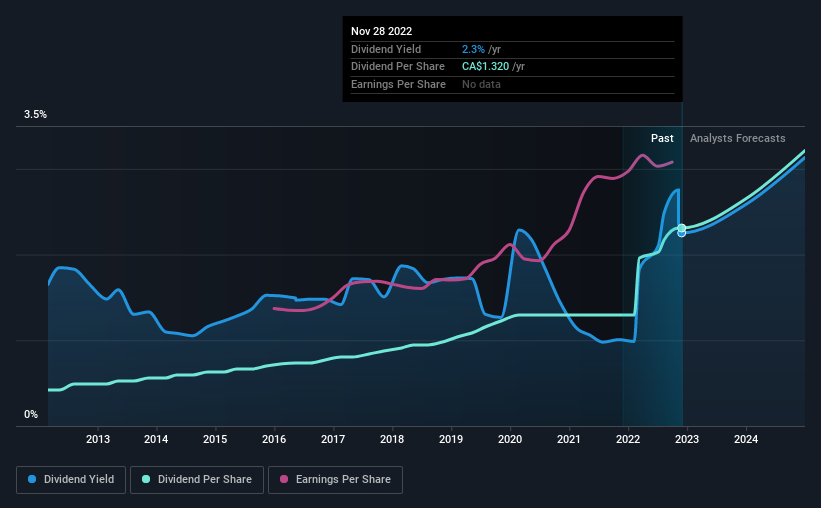
EQB Inc.'s (TSE:EQB) dividend will be increasing from last year's payment of the same period to CA$0.33 on 30th of December. Although the dividend is now higher, the yield is only 2.3%, which is below the industry average.
Check out our latest analysis for EQB
EQB's Dividend Forecasted To Be Well Covered By Earnings
The dividend yield is a little bit low, but sustainability of the payments is also an important part of evaluating an income stock.
EQB has established itself as a dividend paying company with over 10 years history of distributing earnings to shareholders. While past data isn't a guarantee for the future, EQB's latest earnings report puts its payout ratio at 12%, showing that the company can pay out its dividends comfortably.
The next 3 years are set to see EPS grow by 42.3%. The future payout ratio could be 16% over that time period, according to analyst estimates, which is a good look for the future of the dividend.

EQB Has A Solid Track Record
The company has been paying a dividend for a long time, and it has been quite stable which gives us confidence in the future dividend potential. Since 2012, the dividend has gone from CA$0.24 total annually to CA$1.32. This implies that the company grew its distributions at a yearly rate of about 19% over that duration. We can see that payments have shown some very nice upward momentum without faltering, which provides some reassurance that future payments will also be reliable.
The Dividend Looks Likely To Grow
The company's investors will be pleased to have been receiving dividend income for some time. It's encouraging to see that EQB has been growing its earnings per share at 11% a year over the past five years. With a decent amount of growth and a low payout ratio, we think this bodes well for EQB's prospects of growing its dividend payments in the future.
An additional note is that the company has been raising capital by issuing stock equal to 10% of shares outstanding in the last 12 months. Regularly doing this can be detrimental - it's hard to grow dividends per share when new shares are regularly being created.
EQB Looks Like A Great Dividend Stock
Overall, a dividend increase is always good, and we think that EQB is a strong income stock thanks to its track record and growing earnings. Distributions are quite easily covered by earnings, which are also being converted to cash flows. Taking this all into consideration, this looks like it could be a good dividend opportunity.
Market movements attest to how highly valued a consistent dividend policy is compared to one which is more unpredictable. However, there are other things to consider for investors when analysing stock performance. Just as an example, we've come across 2 warning signs for EQB you should be aware of, and 1 of them is a bit concerning. Looking for more high-yielding dividend ideas? Try our collection of strong dividend payers.
Valuation is complex, but we're here to simplify it.
Discover if EQB might be undervalued or overvalued with our detailed analysis, featuring fair value estimates, potential risks, dividends, insider trades, and its financial condition.
Access Free AnalysisHave feedback on this article? Concerned about the content? Get in touch with us directly. Alternatively, email editorial-team (at) simplywallst.com.
This article by Simply Wall St is general in nature. We provide commentary based on historical data and analyst forecasts only using an unbiased methodology and our articles are not intended to be financial advice. It does not constitute a recommendation to buy or sell any stock, and does not take account of your objectives, or your financial situation. We aim to bring you long-term focused analysis driven by fundamental data. Note that our analysis may not factor in the latest price-sensitive company announcements or qualitative material. Simply Wall St has no position in any stocks mentioned.
About TSX:EQB
EQB
Through its subsidiary, Equitable Bank, provides personal and commercial banking services to retail and commercial customers in Canada.
Very undervalued established dividend payer.
Similar Companies
Market Insights
Community Narratives


